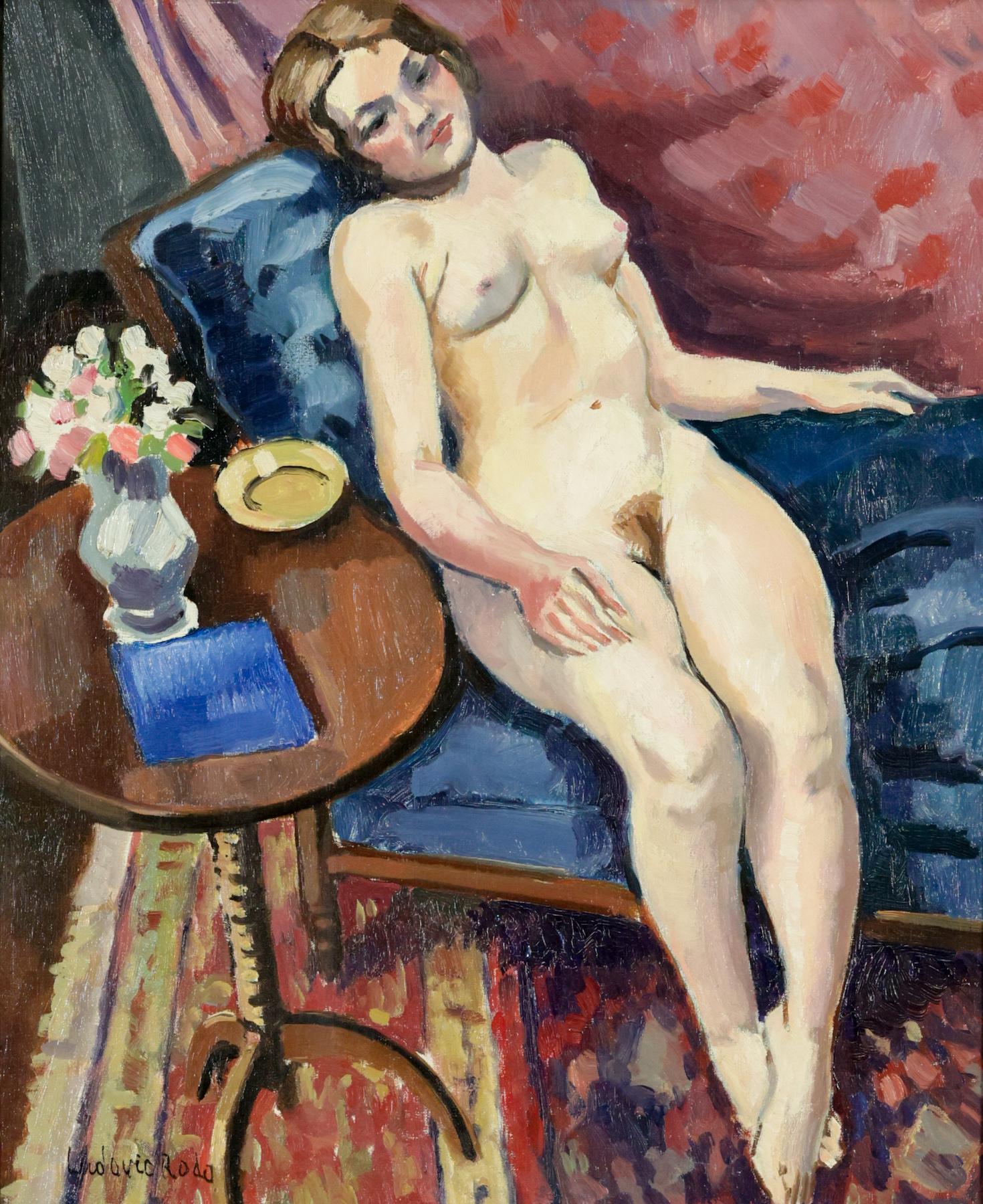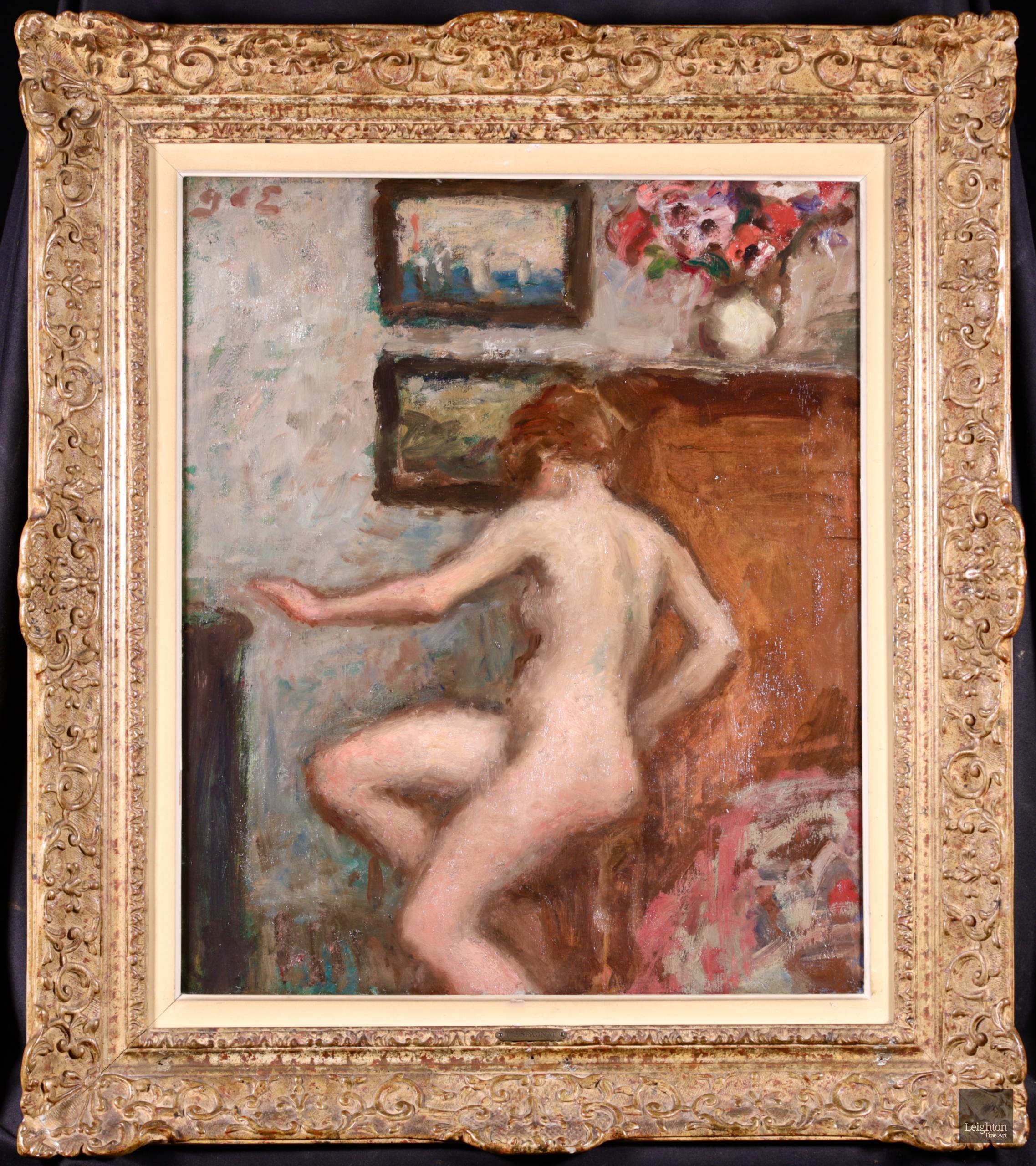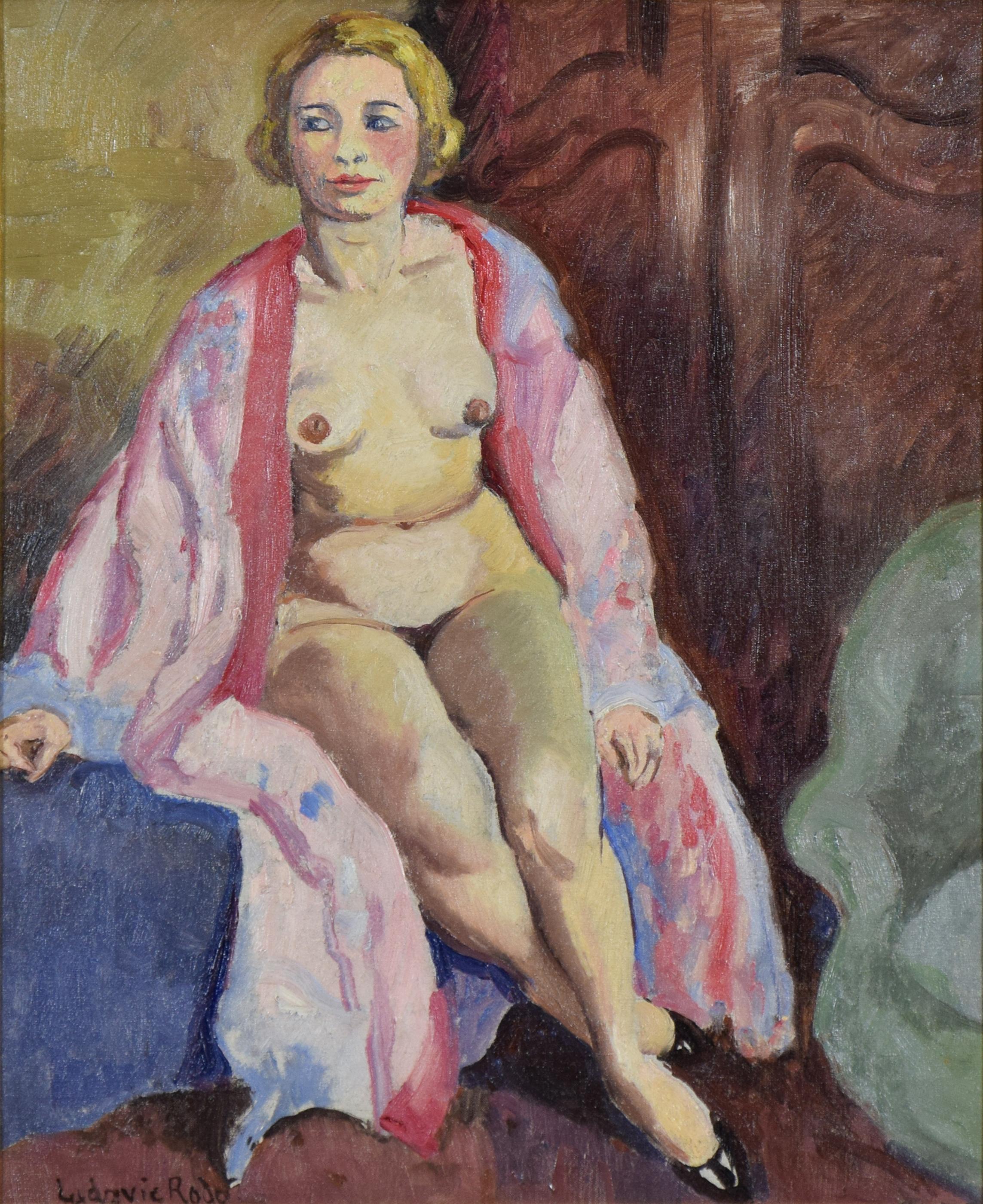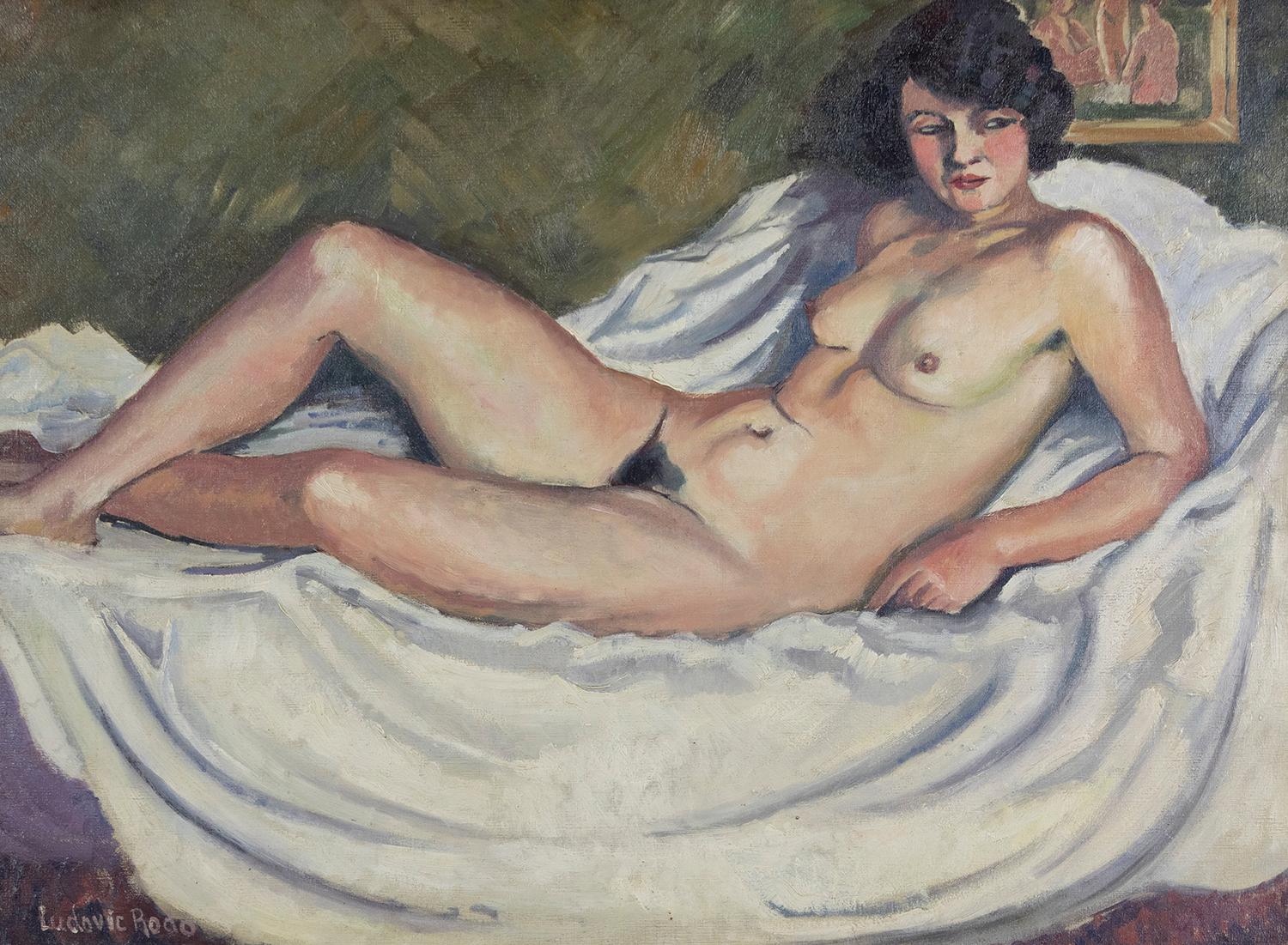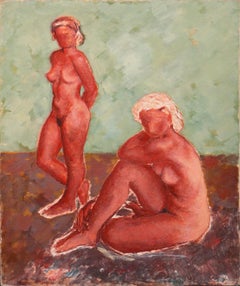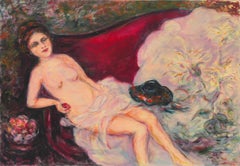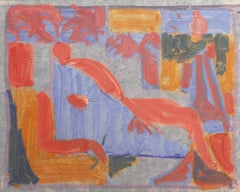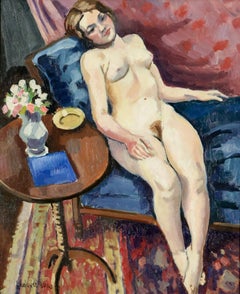
'Bathers at the Beach', Large Danish Post Impressionist Oil, Paris, Benezit
View Similar Items
Want more images or videos?
Request additional images or videos from the seller
1 of 15
Axel Bentzen'Bathers at the Beach', Large Danish Post Impressionist Oil, Paris, Benezit 1933
1933
About the Item
- Creator:Axel Bentzen (1893 - 1952, Danish)
- Creation Year:1933
- Dimensions:Height: 38.25 in (97.16 cm)Width: 40.25 in (102.24 cm)Depth: 0.75 in (1.91 cm)
- Medium:
- Movement & Style:
- Period:
- Condition:minor restoration; unframed.
- Gallery Location:Santa Cruz, CA
- Reference Number:1stDibs: LU3442672903
About the Seller
5.0
Platinum Seller
These expertly vetted sellers are 1stDibs' most experienced sellers and are rated highest by our customers.
Established in 1982
1stDibs seller since 2013
625 sales on 1stDibs
More From This SellerView All
- 'Figural Study, Rust & Jade', Paris, Grønningen, Danish National MuseumBy Helge JensenLocated in Santa Cruz, CASigned lower right, 'Helge' for Helge Jensen (Danish, 1899 - 1986) and painted circa 1925. This Danish Post-Impressionist first studied with Harald Giersing (1915-1916) before initi...Category
1920s Post-Impressionist Nude Paintings
MaterialsOil, Canvas
- 'Reclining Nude', San Francisco Woman Artist, Large Post-Impressionist OilLocated in Santa Cruz, CASigned lower right, 'Vivian R. Huebler' for Vivian Ruth Lewis Huebler (American, 1890-1975); additionally signed, verso, with artist address and painted circa 1955. Vivian Huebler w...Category
1950s Post-Impressionist Figurative Paintings
MaterialsCanvas, Oil
- 'Reclining Nude', Paris, Louvre, Salons d'Automne et Chaumière, LACMA, SFAABy Victor Di GesuLocated in Santa Cruz, CAPainted circa 1955 by Victor Di Gesu (American, 1914-1988) and stamped verso with Victor di Gesu estate stamp. Winner of the Prix Othon Friesz, Victor di Gesu first attended the Los...Category
1950s Post-Impressionist Figurative Paintings
MaterialsRice Paper, Oil
- 'Reclining Nude', Paris, Louvre, Salon d'Automne, Ac. Chaumière, LACMA, SFAABy Victor Di GesuLocated in Santa Cruz, CAPainted circa 1955 by Victor Di Gesu (American, 1914-1988) and stamped verso with Victor di Gesu estate stamp. Winner of the Prix Othon Friesz, Victor di Gesu first attended the Los...Category
1950s Post-Impressionist Figurative Paintings
MaterialsOil, Paper
- 'Reclining Nude', Paris, Louvre, Salon d'Automne, Ac. Chaumière, LACMA, SFAABy Victor Di GesuLocated in Santa Cruz, CAPainted circa 1955 by Victor Di Gesu (American, 1914-1988) and stamped, verso, with Victor di Gesu estate stamp. Winner of the Prix Othon Friesz, Victor di Gesu first attended the L...Category
1950s Post-Impressionist Figurative Paintings
MaterialsOil, Paper
- 'Seated Nude', Paris, Louvre, Salon d'Automne, Académie Chaumière, LACMA, SFAABy Victor Di GesuLocated in Santa Cruz, CAPainted circa 1955 by Victor Di Gesu (American, 1914-1988) and stamped, verso, with Victor di Gesu estate stamp. Winner of the Prix Othon Friesz, Victor di Gesu first attended the L...Category
1950s Post-Impressionist Figurative Paintings
MaterialsGouache, Paper, Watercolor
You May Also Like
- Fernande Horovitz-Edwards, Bathers, Large Oil on Canvas, 1930sLocated in Saint Amans des cots, FRLarge oil on canvas by Fernande Horovitz-Edwards, France, 1930s. "Bathers". With frame: 117,5x90x4 cm - 46.3x35.4x1.6 inches. Without frame: 114x87 cm - 44.9x34.25 inches. Signed low...Category
1930s Post-Impressionist Figurative Paintings
MaterialsCanvas, Oil
- Nu au canapé bleu y Ludovic-Rodo Pissarro - Nude paintingBy Ludovic-Rodo PissarroLocated in London, GB*UK BUYERS WILL PAY AN ADDITIONAL 20% VAT ON TOP OF THE ABOVE PRICE Nu au canapé bleu y Ludovic-Rodo Pissarro (1878-1952) Oil on canvas 46 x 38 cm (18 ¹/₈ x 15 inches) Signed lower left, Ludovic Rodo Executed circa 1910 This work is accompanied by a certificate of authenticity from Lélia Pissarro. Provenance: Private collection, France Artist biography: Ludovic-Rodolphe Pissarro, born in Paris in 1878, was Camille Pissarro’s fourth son. Encouraged by his father...Category
1910s Post-Impressionist Figurative Paintings
MaterialsCanvas, Oil
- Deux Baigneuses dans un Paysage by GEORGES MANZANA PISSARRO - BathersBy Georges Henri Manzana PissarroLocated in London, GBDeux Baigneuses dans un Paysage by GEORGES MANZANA PISSARRO (1871-1961) Oil on canvas 38 x 46 cm (15 x 18 1⁄8 inches) Signed and dated lower left, Manzana Pissarro 55 This work is ...Category
1950s Post-Impressionist Figurative Paintings
MaterialsCanvas, Oil
- Le carnaval du sage by René MagritteBy René MagritteLocated in New Orleans, LARené Magritte 1898-1967 Belgian Le carnaval du sage (The Sage’s Carnival) Signed “Magritte” (lower right); titled and dated "Le carnaval du sage 1947" (en verso) Oil on canvas The enigmatic paintings of René Magritte have become some of the most familiar and celebrated of the Surrealist movement. Among the most influential of the Surrealist painters of the 20th century, Magritte is an artist of international renown, as beloved for his popular appeal as he is for the psychological intensity of his works. The present oil on canvas, entitled Le carnaval du sage, was executed in 1947 at the height of his career, and it is a tour-de-force example of the haunting, mysterious scenes that comprise his oeuvre. Painted in the years following the Second World War, Le carnaval du sage showcases several recurring themes from Magritte’s oeuvre. Chiefly, a juxtaposition between the visible and the hidden is keenly felt. Throughout his career, Magritte explores the psychological obsession with revealing what is hidden, particularly with regard to the human face. In his Le fils de l’homme, he obscures the face of a man in a bowler hat with an apple, while his Les amants (Metropolitan Museum of Art) conceals the faces of two lovers with white sheets. In Le carnaval du sage, Magritte juxtaposes the blatant nudity of his central figure by masking her face, simultaneously revealing and concealing her from the viewer. The work also incorporates two of Magritte’s most common tropes – the glass of water and the baguette. Lending the scene a strange sense of domesticity, they appear infinitely familiar and distinctly out of place, and thus heighten the uncanny effect of Magritte’s composition. In the background hovers a ghost obscured by a sheet, a figure which was of particular fascination to Magritte beginning in 1946. He once wrote to his fellow Surrealist Paul Nougé: "I saw in a dream an answer to the problem of the ghost: the traditional ghost draped...Category
20th Century Post-Impressionist Nude Paintings
MaterialsCanvas, Oil
Price Upon Request - Nude Girl, Polynesian Girl Tahiti, AnnabellaBy Millard SheetsLocated in Miami, FLIn some instances, a painting will look significantly much better in person than it does digitize. This is one instance. In-person, this painting will knock your socks off. It is...Category
1940s Post-Impressionist Nude Paintings
MaterialsOil, Canvas
- Nu avec des fleurs - Post-Impressionist Oil, Nude & Flowers - Georges D'EspagnatBy Georges d'EspagnatLocated in Marlow, BuckinghamshireSigned nude oil on original canvas circa 1910 by French post impressionist painter Georges D'espagnat. The work depict a nude woman seated on a stall turned away from the artist. Paintings hang on the wall and there's a vase filled with pink and red flowers on the wooden mantlepiece beside her. Signature: Signed upper left Dimensions: Framed: 30"x26" Unframed: 22"x18" Provenance: Private French collection. Exhibition stamp verso From the beginning of his career, it was a constant concern of Georges d'Espagnet to assert his originality. His studies at the École des Arts Décoratifs, Paris, did not last very long, for he wanted immediate independence and decided to follow courses in the private academies of Montparnasse. In about 1900, he became acquainted with Maurice Denis, Bonnard and Vuillard, and his collaboration with Denis led to a renewal of religious art in France. In 1903, d'Espagnet was one of the founders of the Salon d'Automne, and was appointed professor in charge of studios at the École des Beaux-Arts, Paris, in 1934. He illustrated a number of books: Rémy de Gourmont's Evil Prayers ( Oraisons mauvaises) (1896), The Saints of Paradise ( Les Saintes du paradis) (1898), Simone (1907), Sistine ( Sixtine) (1922); Alphonse Daudet's The Immortal ( L'Immortel) (1930); André Gide's The Pastoral Symphony ( La Symphonie pastorale); Francis Jammes' Clearings in the Sky ( Chairières dans le ciel) (1948). D'Espagnet belongs to the group of artists who made the Courrier Français so successful. The drawings of his which are published in it are strongly expressive and some bear comparison with the designs of the great Renaissance masters. He also contributed to L'Image. He often placed cheerful nudes in a landscape, reminding us that, though he moved away from the Fauves, he retained their freedom of colour and arabesque. He painted many portraits, including those of Albert André, André Barbier...Category
1910s Post-Impressionist Nude Paintings
MaterialsCanvas, Oil
